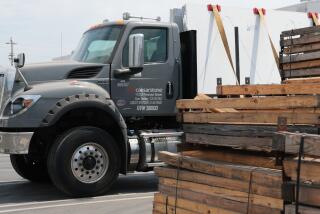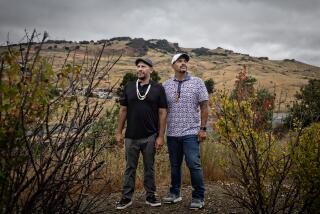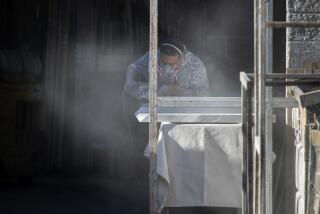Archeologist’s Stand Unearths Controversy : Artifacts: Scientist is accused of illegally taking remains from American Indian site without first notifying authorities. He says he is being persecuted for ridiculing laws requiring reburial.
- Share via
Archeologist David Van Horn is sharp tongued and volatile, not to mention short and red haired, qualities that have earned him the nickname Yosemite Sam.
He earns a living rescuing American Indian remains and artifacts at construction sites, but among some Indians he is considered an enemy. He is scornfully opposed to state-mandated funerals for the bones of prehistoric men. In fact, he was sued for refusing to surrender artifacts for reburial, and lost.
Now, in an unprecedented case that he considers government retaliation for his views, Van Horn and an assistant have been charged with a felony that could send them to the state penitentiary.
“What is the sense of reburying things that belonged to totally anonymous, prehistoric people?” he said recently in an interview at his Sun City lab. “I can’t believe the abject stupidity of what is happening to archeology at the hands of those morons in Sacramento.”
Van Horn’s confrontation with the criminal side of the law over a pound of human bone fragments began about 18 months ago in an abandoned orchard in the desert resort of Indian Wells.
A company planning to build houses had hired the Riverside County scientist to ensure that nothing of archeological significance would be destroyed by construction. Van Horn and an assistant surveyed the 23-acre site, then singled out a patch of pottery- and charcoal-strewn ground for a closer look. The assistant, Robert Scott White, later dug a trench there six inches deep and three feet square.
It yielded more pottery shards and charcoal, as well as dozens of pieces of bone, none larger than a quarter. White filled several plastic garbage bags with the specimens and dirt and took them to Van Horn’s lab.
Neither man called the county coroner to report the discovery of Indian remains, as required by state law. Instead, Van Horn sent the pound of bone chips gleaned from the dig to UCLA for positive identification as animal or human.
Van Horn and White are accused of illegally removing human remains from an American Indian cremation site. Scientists and prosecutors say they know of no other case in which professional archeologists have faced criminal charges stemming from their work. If convicted, they could be sent to prison for three years. They have pleaded not guilty. A preliminary hearing is scheduled in Indio on Oct. 16.
Van Horn says nobody could have known the bones were human without an expert’s analysis. He also claims he is being prosecuted--indeed “persecuted”--because he is in the habit of ridiculing laws that require the reburial of Indian remains and artifacts.
“The job was to assess the importance of the find, and we couldn’t assess the find without sending this stuff to a lab,” he said.
“I believe the reason I’m being persecuted is because I’m an open adversary of the Native American Heritage Commission and the attorney general’s office, both of which are bending over backward to get all this anti-archeological legislation installed, and I am bending over backward to make all that difficult.”
Officials say they are just enforcing the law.
“We have substantial Indian lands in Riverside County, and I think it is an obligation of our office to safeguard those lands and the heritage of the Indians, which unfortunately some individuals will unscrupulously take advantage of,” Dist. Atty. Grover C. Trask II said.
It was the attorney general’s office which referred the case to Trask, noting in a July, 1989, letter its “previous dealings with Dr. Van Horn.” (The state sued Van Horn in 1986 after he refused on principle to surrender two milling stones unearthed with a pair of 300-year-old skeletons.)
In April of this year, about a year after White’s spade went into the ground, Van Horn was drinking his breakfast coffee when half a dozen county investigators poured out of three cars. They blocked his driveway and presented him with a search warrant.
“They ransacked this place--the house, the garage, the office, the lab,” Van Horn recalled. “Six people were going through this place like we were drug dealers or something.” His 8-year-old son had just gone to school. His wife, Ruth, was allowed to take their daughter, a toddler, to a baby-sitter.
He heard nothing for several weeks, then was notified by mail that he had been charged with the crime and should present himself in Indio Municipal Court.
The case marks the first use of a 1988 state law making Indian grave desecration a felony. It also embodies a passionate national debate over the treatment of American Indian remains.
Laws in many states, including California, require bones and grave artifacts to be treated like human bodies and sacred objects, not research material. Pending federal legislation would go further by forcing museums to negotiate with Indians over the return of bones and artifacts dug up decades ago.
Van Horn is an outspoken critic of the so-called repatriation movement, and some colleagues share his suspicion that he is being attacked for his opinions.
“He’s allowing himself to be nailed to the cross,” said Clement Meighan, a UCLA anthropology professor and chairman of a national group called the American Committee for the Preservation of Archeological Collections.
“I’ve done everything he’s done and more besides and said so publicly on numerous occasions,” Meighan said. “But the attorney general won’t nail me, because I’m a professor at UCLA. I’m in a more senior position. They go after Van Horn because they think he’s vulnerable.”
Larry Myers, executive secretary of the state Native American Heritage Commission, denied that Van Horn has been targeted. “I think there are a lot of other people that speak out against repatriation, and are they all going to jail? No. I have nothing against Van Horn. My only concern is that the law be followed.”
Deputy State Atty. Gen. Louis Verdugo said his office “would categorically deny that” politics are behind Van Horn’s prosecution. He called the referral to local authorities routine.
Van Horn, 46, has a doctorate from the University of Pennsylvania but, like a growing number of archeologists, is not affiliated with a university. As a self-employed consultant, he does much of his professional work for land developers under a state law designed to protect potential archeological sites from bulldozers.
Between archeology jobs he sometimes operates a bulldozer on small jobs around Sun City, but he also edits a journal called the Pacific Coast Archeological Society Quarterly and has written manuals on excavation.
He said he was concerned about the possibility of jail but hoped the charges will be dismissed. His attorney, Gary C. Scherotter of Palm Springs, would not talk about strategy. Deputy Dist. Atty. Richard Erwood, who is handling the case, says surface bits of charcoal and charred pottery should have alerted the archeologists that a cremation site lay below, especially in artifact-rich Indian Wells.
Once White had found bone fragments, they should have immediately contacted the property owner or the coroner, Erwood said.
Van Horn said the bits of bone and pot could have signified cooking as well as cremation. He noted that the Cahuilla Indians who inhabited the area cremated their dead but left the remains on the ground.
Osteologist William Bass, an expert in human bones who trained several anthropologists at the Smithsonian Institution, said it is extremely difficult to identify small pieces of bone in the field and that Van Horn was correct in sending his specimens to UCLA.
Mark Lynott, a Nebraska archeologist and president of the national Society of Professional Archeologists, said Van Horn was using “standard field and lab procedures” and called his prosecution “an appalling situation.”
Van Horn’s battle with the Native American Heritage Commission began almost five years ago in northern San Diego County outside Vista.
Surveying a development site, Van Horn found two male skeletons in an unmarked grave whose rubble included two milling stones or metates (pronounced meh-TAH-tay). The commission sought the stones’ return for reburial with the skeletons. Van Horn refused, prompting the state’s civil suit. He acknowledges he wanted to challenge the grave law in court.
Van Horn unsuccessfully insisted the metates were coincidental to the grave and not part of a religious ceremony. At least one of the skeletons had a skull fracture and both were upside down, suggesting murder and hasty burial, not a religious ritual, he said. Van Horn lost an appeal in March.
Seven months later, the skeletons and stones remain in storage at the San Diego Museum of Man. A group of Indian elders has visited to check on them but hasn’t decided how to bury them, officials said.
Van Horn says he’s still paying off $30,000 in debts incurred in the lawsuit.
“All of this is absolute financial ruination for me,” Van Horn said. “But there’s more to life than money, and I feel that these issues are very important. I feel that someone has to object to what’s going on.”
More to Read
Sign up for Essential California
The most important California stories and recommendations in your inbox every morning.
You may occasionally receive promotional content from the Los Angeles Times.










